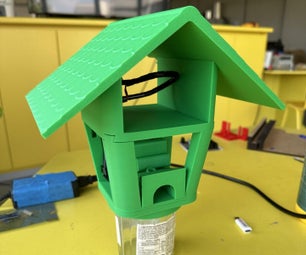Introduction: How to Make a Simple Electric Guitar
This is a step by step instruction of how to make an one-string simple electric guitar.
This was originally experimented by Paul in the museum's Curiosity Lab .
Children should work with a responsible adult helping your with your project!
What you need:
(1) 1x2 White Pine lumber approx. 12" in length
24 AWG magnet wire
Winding Jig (Instructable coming soon)
Epoxy
220 Grit sand paper
(1) Neodymium magnet 1/4" x 1/4" cylinder
(1) Jumbo craft stick
(1) #12 Screw eye
Security cable 22 AWG strand
(1) 3.5mm (1/8") Mono plug
Steel wire
Wire strippers
Screwdriver
Guitar pick
(Other tools + materials not shown in the image)
Medium binder clip
Soldering iron
Solder
Scissors
Hot glue gun
Step 1: Glueing Magnet Sandwich
1. Roughen up both sides of your neodymium magnet by scraping on your sand paper.
2. Cut your jumbo craft stick to make two 1" x 1" square pieces.
3. Epoxy the magnet to your craft stick piece.
*Please read hazards + instructions for using epoxy.
4. Epoxy both sides of magnet to create magnet craft stick sandwich.
Step 2: Winding Magnet Sandwich
1. Slap magnet craft stick sandwich on the disk of winding jig.
2. Send copper wire through eye of needle.
3. Tape copper wire to the spinning disc.
4. Wind the copper wire around the magnet.
*100+ windings is recommended. Try and see what works best for yourself!
5. Cut the wire from the spool with a few inches of wire unwound from magnet.
6. Scrape enamel coating off of magnet wire about 1" from the end of wire.
Your magnet sandwich should now have a copper winding with two ends of wire dangling out and both ends exposed.
Step 3: Preparing the Plug
1. Solder the security cable to the 3.5mm plug.
Your cable should look like the second picture below.
Step 4: Building Guitar
1. Pre-drill a pilot hole in your guitar body (white pine) and screw in your screw.
2. Cut your steel wire approx. 8" longer than your guitar body.
3. Wrap the steel wire around your screw head.
4. Place your medium binder clip under your steel wire.
5. Wrap your wire around the side of the loop to your #12 screw eye.
6. Pre-drill a 1/16" pilot hole and screw your #12 screw eye into your guitar body. Use the screw eye to "tune" your string.
*Don't over tighten your string.
This is your single string guitar! It should closely resemble the last image shown below.
Step 5: Attaching Pickup to Guitar
1. Attach the exposed wires of your magnet sandwich to your security cable with 3.5mm plug.
2. Hot glue your pickup (magnet sandwich) to the guitar.
3. Staple the security cable to the guitar body.
Step 6: Playing the Guitar
1. Plug your electric guitar into the microphone jack of your computer.
2. Open Audacity or sound recorder and play your guitar!
That's it! Have fun jamming on your electric guitar.










